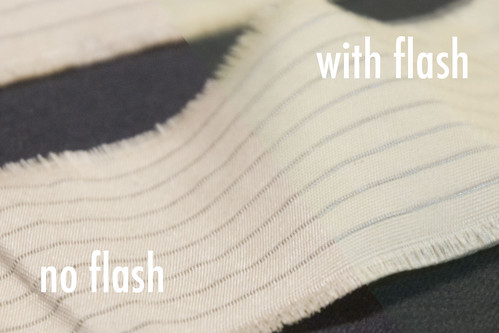This is an update on an ongoing project. I wrote this months ago, but forgot to post it. There will be more posts on new progress soon!
This is a photograph of a test swatch of retroreflective fabric. Alan Paukman and Jacob Melinger of Nikolai Rose helped. But the key producers were Bethane Knudson and the Oriole Mill.
The image doesn't show it too well, but the threads definitely reflect nicely.
We have had a lot of trouble making it work. Bethane writes about the problems she encountered:
We encountered a number of challenges with using the 3M Scotchlite "yarn". The Scotchlite stretches and breaks when pulled from the spool. Our crew tried various approaches but the breakage continued. We then re-wound the Scotchlite onto a yarn package, called a cone. This allowed for an even release of the Scotchlite which the spool did not. However, having eliminated the problem of the spool, we encountered a new problem --going through the accumulator which feeds the weft to the rapier also stretched and broke the Scotchlite. We slowed the weaving machine down further and that helped but did not eliminate the problem. While some of the problems in using Scotchlite might be resolved with further investment of time and resources, some cannot. The Scotchlite is not well suited to weaving on the industrial loom. While the Scotchlite has some stretch, it has no recovery -- meaning when it stretches, it distorts and does not return to its original state. This would mean that as the garment is worn, the fabric will stretch and would return to its original state, except for the Scotchlite weft. The stretched Scotchlite would ripple, like a seersucker effect, and would eventually break. Scotchlite is too weak to be used as a warp thread and it not really strong enough to be used in the weft for a garment. The demand put on a garment -- especially pants -- is significant. The other problem is that a pinstripe is, by definition, a line that runs vertically. Since we used the Scotchlite in the weft, the lines run horizontally. Because garments are cut with the grain of the fabric, the pinstripes will become pin-bands rather than pinstripes. (In some cases the fabric can be used in the horizontal orientation but this limits the length of the pant and alters the drape radically. The warp direction has the best drape.)
